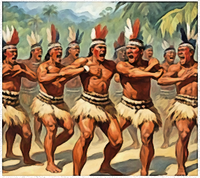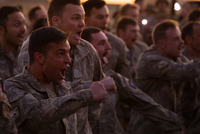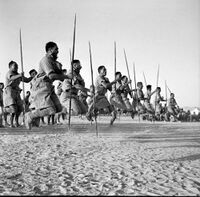User:Krugmar/Khimba
Khimba (Gaullican: /kɛ̃'ba/; Marai: /ˈximba/) is the name for a group of ceremonial and war dances in Marai culture. Originally a maligned tradition of the native peoples of Satucin, it became part of the national culture during the l'éveil of the late 19th and early 20th centuries. Its adoption by sports teams and the Union Army helped make it more widely known and cemented it as a cultural feature of Satucin.
It is usually performed as a group, with most forms incorporating shouting, rhythmic chanting, and vigorous movements. The dance is often used to welcome guests, celebrate important events, and pay tribute to ancestors and the recently deceased. The two most common forms are the Khimba Roi, and the Khimba Rouge. The Khimba Roi, a ceremonial dance, is the most well-known, being a more highly choregraphed performance involving stomping in unison, slapping of thighs and chest, accompanied by chanting, yelling, sticking out the tongue and baring the teeth, and occasionally music is involved. The Khimba Rouge, descending from Marai war dances, differs in that the participants hold and involve weapons, and are more vigorous in movement, jumping and charging, with the performance usually being more improvised.
Originating with the Marai Civilisation, the first reference to it is in the Bethune Codex from the Marai city of Tsochoksa, which has been dated to the 400s CE. Warfare was endemic between the Marai city-states of the classical era, and the war dance aspects of the khimba may have developed as either a replacement for combat, allowing the two sides to compete physically but non-violently, or as a pre-battle attempt to shock the enemy. Most Marai scholars argue however that the majority of khimba routines have their origins in ritualistic, religious, ceremonial, and folk dances and that the emphasis on its nature as a war dance is a modern exaggeration due to the perceived aggressive nature of the dances.
Etymology
History
Origins
- reference the Ok'uocha, who seem to have used it extensively (evidence perhaps from paintings in Cutinsua, or writings in Tzapotlan?)
Colonial
Modern
Cultural influence
Sports
Military
test
Notes
to be deleted
Khimba Roi - main version without weapons, largely static, most well known, used by Satucine sports teams and most other institutions
Khimba Rouge - version with weapons, hopping about, used by the Satucine military
Khimba Griffe - version created by descendants of maroons and natives, spreading later to black and mixed communities throughout Satucin


